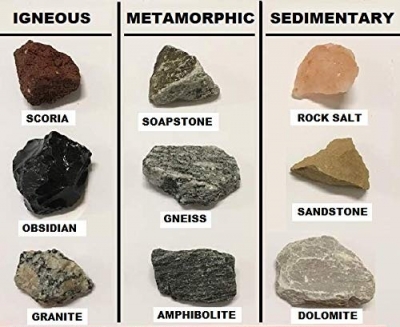
|
There are three kinds of rocks: igneous, sedimentary and metamorphic. Igneous rocks are formed when red-hot magma flows up from Earth’s hot core and cools down. Sedimentary rocks form when debris, including plant and organic matter, usually deposited on the seabed in layers, is built up, compressed and cemented into solid rock over millions of years. Metamorphic rocks are created when movements of Earth’s crust or the heat of its magma transforms one kind of rock into another. |
Rocks are mineral aggregates with a combination of properties of all the mineral traces. Any unique combination of chemical composition, mineralogy, grain size, texture, or other distinguishing characteristics can describe rock types. Additionally, different classification systems exist for each major type of rock. There are different types of rocks existing in nature.
Rocks which are found in nature rarely show such simple characteristics and usually exhibit some variation in the set of properties as the measurement scale changes.
Types of Rocks
There are three types of rocks:
Igneous Rock
Igneous rock is one of the three main rock types. Igneous rock is formed through the cooling and solidification of magma or lava. Igneous rock may form with or without crystallization, either below the surface as intrusive (plutonic) rocks or on the surface as extrusive (volcanic) rocks.
Sedimentary Rock
The sedimentary rocks are formed by the deposition and subsequent cementation of that material within bodies of water and at the surface of the earth. The process that causes various organic materials and minerals to settle in a place is termed as sedimentation.
Metamorphic Rocks
The metamorphic rocks make up a large part of the Earth’s crust and are classified by texture and by chemical and mineral assemblage. They may be formed simply by being deep beneath the Earth’s surface, subjected to high temperatures and the great pressure of the rock layers above it.
Credit: Byju’s
Picture credit: Google




